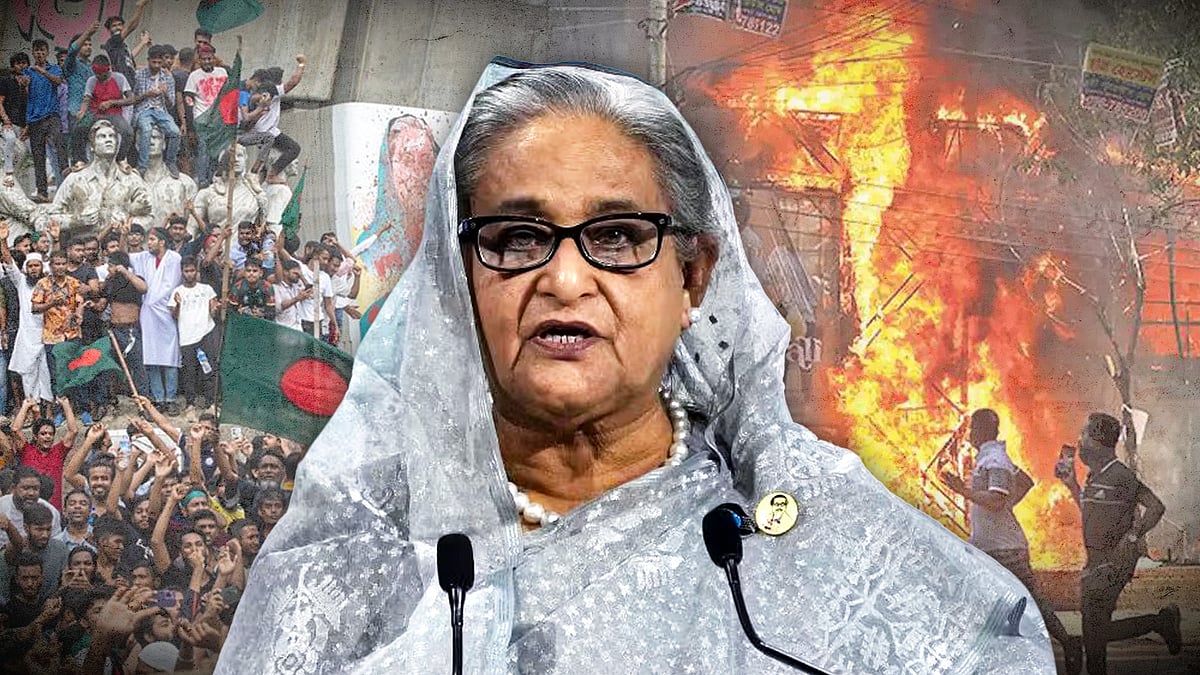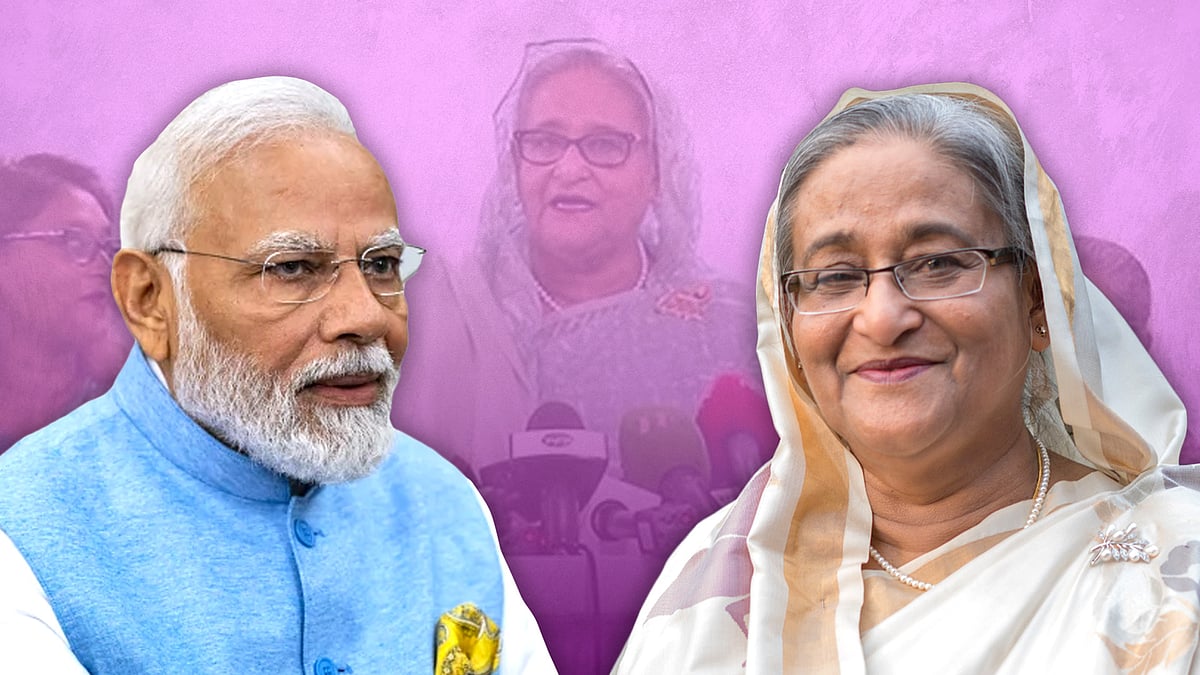Security, foreign designs, new power centres: Delhi’s Dhaka concerns checklist growing bigger
With a trickier neighbourhood, it’s clear that Delhi can’t be complacent on Dhaka.
The unceremonious end of the Sheikh Hasina-led Awami League’s 15-year regime in Bangladesh has meant a delicate set of new equations in India’s northeastern neighbourhood.
The reset of the power matrix in Dhaka, and more so the manner in which it was shaped, will call for strategic recalibration in New Delhi. It foregrounds the need to keep a close eye on the different variants at play, evaluating the elements of continuity, and considering the forces of change in India’s ties with Bangladesh.
In some ways, the moment is closer to what New Delhi came across when General Ershad seized power in Dhaka in 1982, even though the military doesn’t seem so much in control of the situation now.
Questions around interim government, security
First, the immediate question for New Delhi is how to view the interim government, bereft of the Awami League, in light of the current status of Indo-Bangladesh ties. This becomes significant in the backdrop of the fact that the former PM and her party’s tenure gave a boost to Indo-Bangla ties in different areas of bilateral engagement. This was as much true for her unbroken 15-year run in the office as it was for her previous stint from 1996 to 2001. Besides offering a stabilising presence in India’s eastern neighbourhood, New Delhi found common ground with her government’s crackdown on terror camps, action against Islamist fundamentalists and forces inimical to India’s territorial integrity. Moreover, the marked improvement in trade ties and the bilateral thrust given to maritime and transport infrastructure were significant aspects of the Delhi-Dhaka engagement in the last decade or so.
The high point was of course the resolution of a lingering irritant through the revised Land Boundary Agreement of June 2015. Even the defence cooperation between the two countries was on the upswing. As recently as last month, Dhaka used a part of the $500 million line of credit extended by New Delhi to conclude a deal with the Indian defence shipyard GRSE to build an 800-tonne advanced ocean-going tug.
But, that doesn’t mean that India has been reluctant to engage with governments led by other parties in Bangladesh.
In fact, in the past, New Delhi, without much success had been keen on engaging with Begum Khaleda Zia-led Bangladesh National Party (BNP). But the party’s anti-India rhetoric, coupled with its understanding with Jamaat-e-Islami, never made it a natural ally for India which looked for a regime that could add to regional stability, act against forces aiming to undermine India’s security interests and work for exploring mutuality of economic and defence interests.
Second, India’s immediate gaze would be turned towards managing its 4,000 km-long border with Bangladesh. Along with the possibility of current political turmoil stoking the influx of those fleeing and wanting to sneak in, the long border is also the vulnerable gateway to the threat of terror activities, human trafficking, drugs and counterfeit currency.
In some ways, the cooperation with the just ousted regime stood India in good stead in guarding the borders against these threats. New Delhi will have to try afresh to see that the interim government in Dhaka doesn’t lower its guard on border cooperation. India can’t afford to lose sight of the fact that a lenient approach in Dhaka could mean that radical and secessionist elements in the north-east might try to find a foothold in border districts.
The Chinese interest
Third, New Delhi would be alert to the possibilities of a larger foreign design behind the protests and eventual regime change in Dhaka. The probabilities can range from a Beijing-ISI nexus to a Washington role for a more supplicant regime. The possibilities couldn’t be ruled out, like any power play in international relations.
Hasina had been aware of China’s interest in extending Beijing’s sphere of influence to Bangladesh. She did accommodate the Chinese side on some counts, but not to the degree that Beijing would have liked. Even if Bangladesh was careful about not allowing its economic ties with China and India to clash, there were times when they did seem competitive. In recent times, Hasina’s preference for India to execute the Teesta project, in which China too was interested, was a case in point.
There were some signs of China’s growing distance from Hasina’s regime, even if Dhaka was keen on not ruffling Xi Jinping’s feathers. Unlike Hasina’s 2016 Beijing visit, her recent visit to China was mostly cold-shouldered by top Chinese authorities, and brought little financial assistance to Bangladesh, as pointed out by Veena Sikri, former diplomat who also served as India’s High Commissioner to Bangladesh.
The strategic motivations of Pakistan-China nexus to destabilise the current regime and mount a friendly regime in Dhaka can’t be ruled out, especially if that means a regime imbued with anti-Indian sentiments. But the reverse theory is that of a Washington ploy to keep the region under check with a vassal state that can be used as a military base for more concessions from India, and a counter to China’s growing clout in the region. Both ways, India would be assessing these possibilities and implications with a sense of strategic alertness.
The key player in Dhaka, and Indians in Bangladesh
Fourth, New Delhi would also be aware of the need to identify whom to engage seriously in the new power structure in the Bangladeshi capital.
Given the fact that the cycle of violence hasn’t ended yet, the unabated uncertainty doesn’t give a sense of settled power equations. While some immediate response is needed, the deeper engagement with the new regime will need diplomatic patience. This implies that New Delhi will need to wait out the emergence of the contours of a new political landscape before resuming deeper engagements both at diplomatic levels and at the summit level. The longer commitments can wait out to the unfolding phase, while the immediate responses can take care of the exigency of the moment.
Fifth, the security of Indians working or studying in Bangladesh will be a major concern for India. Last month, India had evacuated around 7000 Indian students and professionals from Bangladesh, and the current situation may ask for such efforts. That, however, is aggravated by the fact that there have been reports of attacks on members of the minority Hindu community, who are otherwise citizens of Bangladesh. A BBC report has quoted Debapriya Bhattacharya, a senior economist with the Centre for Policy Dialogue in Dhaka, to inform that in the aftermath of Sheikh Hasina’s resignation yesterday, attacks on the Hindu minority have escalated. New Delhi will be expected to raise the issue.
The creation of the new sovereign nation of Bangladesh in 1971, accompanied by the dismemberment of Pakistan, is still seen as one of the most cherished outcomes for India’s foreign policy.
In the intervening five decades, this also meant that in India’s northeastern neighbourhood, a hostile state was replaced by a politically volatile state. Warts and all, Sheikh Hasina-led Awami League regime marked a period of stabilising effect on Indo-Bangladesh ties which resolved some long standing border issues, boosted economic ties and bridged the trust deficit. With the end of that era, New Delhi has a lot to watch out for.
.jpg?auto=format%2Ccompress) On front pages: Attacks on Hindu homes, Hasina’s phone call, and Delhi impact
On front pages: Attacks on Hindu homes, Hasina’s phone call, and Delhi impact No happy endings for India on Hasina’s road to exit
No happy endings for India on Hasina’s road to exit ‘Shadow’ on US ties, China factor: What Hasina’s re-election means for India
‘Shadow’ on US ties, China factor: What Hasina’s re-election means for India